People, Culture, and Contemporary Leadership: A Reflective Journal
VerifiedAdded on 2022/11/17
|10
|2404
|96
Journal and Reflective Writing
AI Summary
This reflective journal, submitted for the MBA401 People, Culture, and Contemporary Leadership course, delves into the complexities of leadership by examining various theories, styles, and their practical implications. The student explores leadership succession, behavior, traits, and styles like autocratic, democratic, transformational, and laissez-faire. The journal connects these theoretical concepts to in-class activities, such as analyzing charismatic leaders and situational leadership scenarios. Furthermore, it includes personal reflections on leadership experiences, highlighting the evolution of the student's understanding and application of leadership skills, including the identification of their democratic leadership style and its strengths and weaknesses. The conclusion emphasizes the importance of adapting leadership styles based on the situation and the continuous development of leadership skills for effective outcomes.
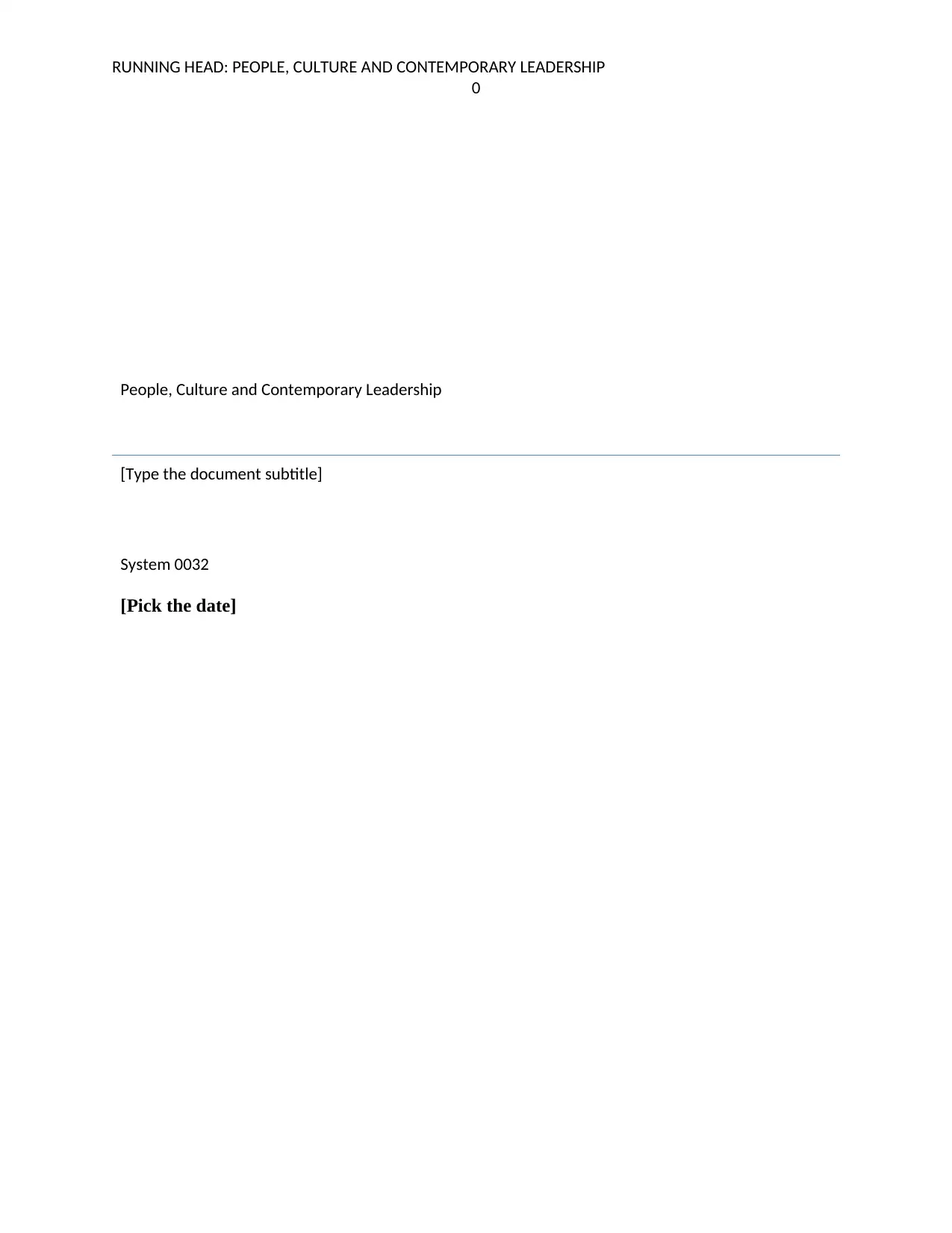
RUNNING HEAD: PEOPLE, CULTURE AND CONTEMPORARY LEADERSHIP
0
People, Culture and Contemporary Leadership
[Type the document subtitle]
System 0032
[Pick the date]
0
People, Culture and Contemporary Leadership
[Type the document subtitle]
System 0032
[Pick the date]
Paraphrase This Document
Need a fresh take? Get an instant paraphrase of this document with our AI Paraphraser
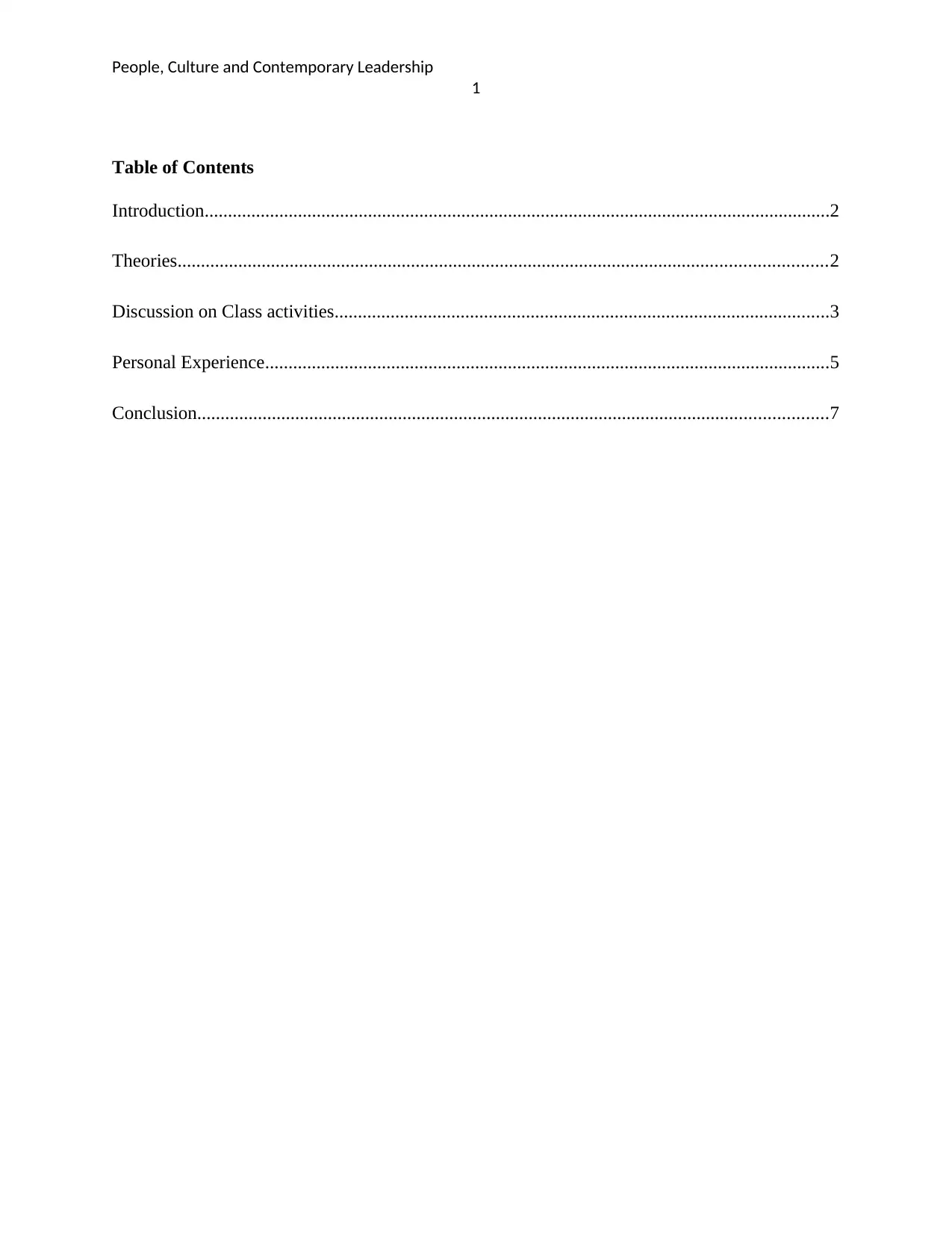
People, Culture and Contemporary Leadership
1
Table of Contents
Introduction......................................................................................................................................2
Theories...........................................................................................................................................2
Discussion on Class activities..........................................................................................................3
Personal Experience.........................................................................................................................5
Conclusion.......................................................................................................................................7
1
Table of Contents
Introduction......................................................................................................................................2
Theories...........................................................................................................................................2
Discussion on Class activities..........................................................................................................3
Personal Experience.........................................................................................................................5
Conclusion.......................................................................................................................................7
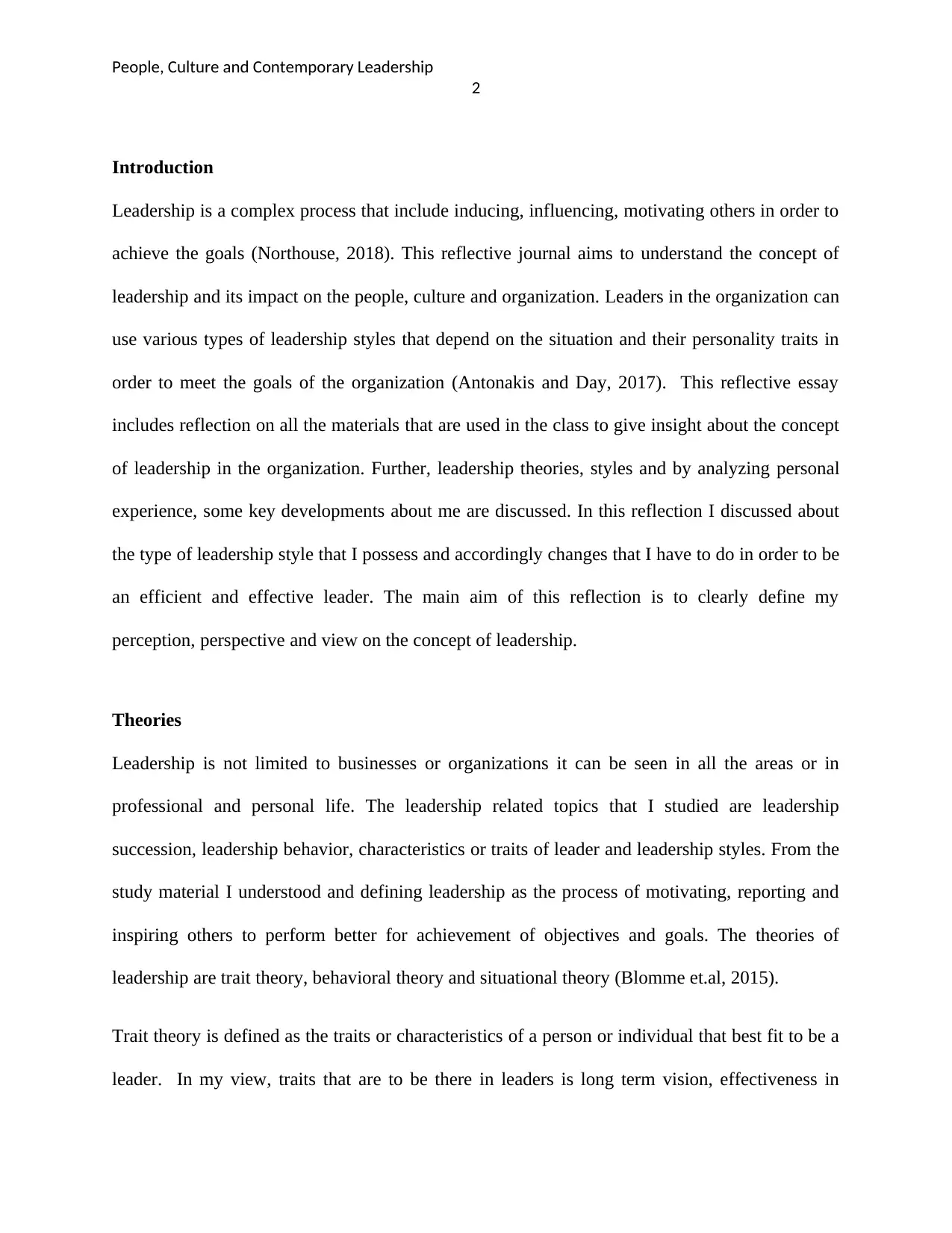
People, Culture and Contemporary Leadership
2
Introduction
Leadership is a complex process that include inducing, influencing, motivating others in order to
achieve the goals (Northouse, 2018). This reflective journal aims to understand the concept of
leadership and its impact on the people, culture and organization. Leaders in the organization can
use various types of leadership styles that depend on the situation and their personality traits in
order to meet the goals of the organization (Antonakis and Day, 2017). This reflective essay
includes reflection on all the materials that are used in the class to give insight about the concept
of leadership in the organization. Further, leadership theories, styles and by analyzing personal
experience, some key developments about me are discussed. In this reflection I discussed about
the type of leadership style that I possess and accordingly changes that I have to do in order to be
an efficient and effective leader. The main aim of this reflection is to clearly define my
perception, perspective and view on the concept of leadership.
Theories
Leadership is not limited to businesses or organizations it can be seen in all the areas or in
professional and personal life. The leadership related topics that I studied are leadership
succession, leadership behavior, characteristics or traits of leader and leadership styles. From the
study material I understood and defining leadership as the process of motivating, reporting and
inspiring others to perform better for achievement of objectives and goals. The theories of
leadership are trait theory, behavioral theory and situational theory (Blomme et.al, 2015).
Trait theory is defined as the traits or characteristics of a person or individual that best fit to be a
leader. In my view, traits that are to be there in leaders is long term vision, effectiveness in
2
Introduction
Leadership is a complex process that include inducing, influencing, motivating others in order to
achieve the goals (Northouse, 2018). This reflective journal aims to understand the concept of
leadership and its impact on the people, culture and organization. Leaders in the organization can
use various types of leadership styles that depend on the situation and their personality traits in
order to meet the goals of the organization (Antonakis and Day, 2017). This reflective essay
includes reflection on all the materials that are used in the class to give insight about the concept
of leadership in the organization. Further, leadership theories, styles and by analyzing personal
experience, some key developments about me are discussed. In this reflection I discussed about
the type of leadership style that I possess and accordingly changes that I have to do in order to be
an efficient and effective leader. The main aim of this reflection is to clearly define my
perception, perspective and view on the concept of leadership.
Theories
Leadership is not limited to businesses or organizations it can be seen in all the areas or in
professional and personal life. The leadership related topics that I studied are leadership
succession, leadership behavior, characteristics or traits of leader and leadership styles. From the
study material I understood and defining leadership as the process of motivating, reporting and
inspiring others to perform better for achievement of objectives and goals. The theories of
leadership are trait theory, behavioral theory and situational theory (Blomme et.al, 2015).
Trait theory is defined as the traits or characteristics of a person or individual that best fit to be a
leader. In my view, traits that are to be there in leaders is long term vision, effectiveness in
⊘ This is a preview!⊘
Do you want full access?
Subscribe today to unlock all pages.

Trusted by 1+ million students worldwide
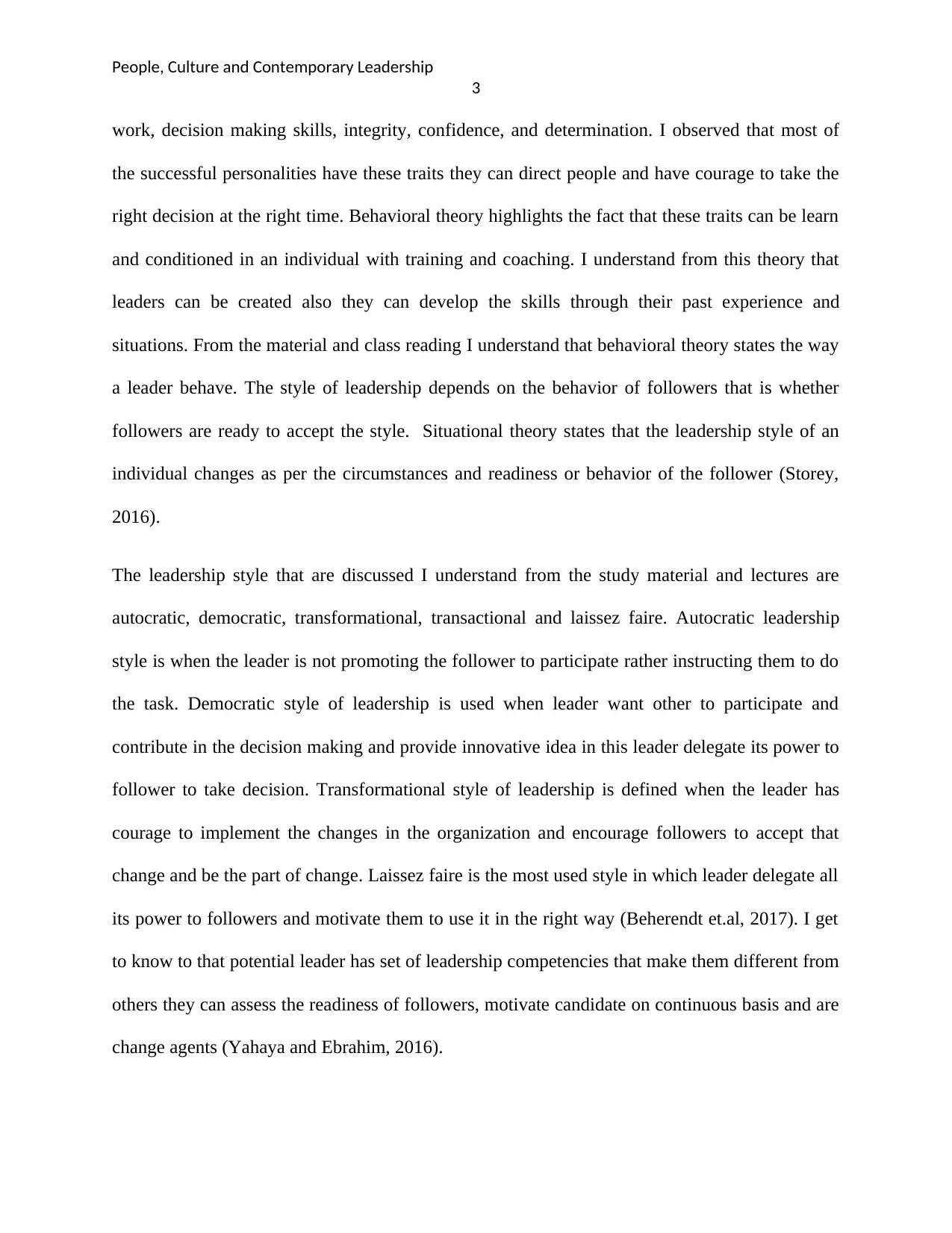
People, Culture and Contemporary Leadership
3
work, decision making skills, integrity, confidence, and determination. I observed that most of
the successful personalities have these traits they can direct people and have courage to take the
right decision at the right time. Behavioral theory highlights the fact that these traits can be learn
and conditioned in an individual with training and coaching. I understand from this theory that
leaders can be created also they can develop the skills through their past experience and
situations. From the material and class reading I understand that behavioral theory states the way
a leader behave. The style of leadership depends on the behavior of followers that is whether
followers are ready to accept the style. Situational theory states that the leadership style of an
individual changes as per the circumstances and readiness or behavior of the follower (Storey,
2016).
The leadership style that are discussed I understand from the study material and lectures are
autocratic, democratic, transformational, transactional and laissez faire. Autocratic leadership
style is when the leader is not promoting the follower to participate rather instructing them to do
the task. Democratic style of leadership is used when leader want other to participate and
contribute in the decision making and provide innovative idea in this leader delegate its power to
follower to take decision. Transformational style of leadership is defined when the leader has
courage to implement the changes in the organization and encourage followers to accept that
change and be the part of change. Laissez faire is the most used style in which leader delegate all
its power to followers and motivate them to use it in the right way (Beherendt et.al, 2017). I get
to know to that potential leader has set of leadership competencies that make them different from
others they can assess the readiness of followers, motivate candidate on continuous basis and are
change agents (Yahaya and Ebrahim, 2016).
3
work, decision making skills, integrity, confidence, and determination. I observed that most of
the successful personalities have these traits they can direct people and have courage to take the
right decision at the right time. Behavioral theory highlights the fact that these traits can be learn
and conditioned in an individual with training and coaching. I understand from this theory that
leaders can be created also they can develop the skills through their past experience and
situations. From the material and class reading I understand that behavioral theory states the way
a leader behave. The style of leadership depends on the behavior of followers that is whether
followers are ready to accept the style. Situational theory states that the leadership style of an
individual changes as per the circumstances and readiness or behavior of the follower (Storey,
2016).
The leadership style that are discussed I understand from the study material and lectures are
autocratic, democratic, transformational, transactional and laissez faire. Autocratic leadership
style is when the leader is not promoting the follower to participate rather instructing them to do
the task. Democratic style of leadership is used when leader want other to participate and
contribute in the decision making and provide innovative idea in this leader delegate its power to
follower to take decision. Transformational style of leadership is defined when the leader has
courage to implement the changes in the organization and encourage followers to accept that
change and be the part of change. Laissez faire is the most used style in which leader delegate all
its power to followers and motivate them to use it in the right way (Beherendt et.al, 2017). I get
to know to that potential leader has set of leadership competencies that make them different from
others they can assess the readiness of followers, motivate candidate on continuous basis and are
change agents (Yahaya and Ebrahim, 2016).
Paraphrase This Document
Need a fresh take? Get an instant paraphrase of this document with our AI Paraphraser
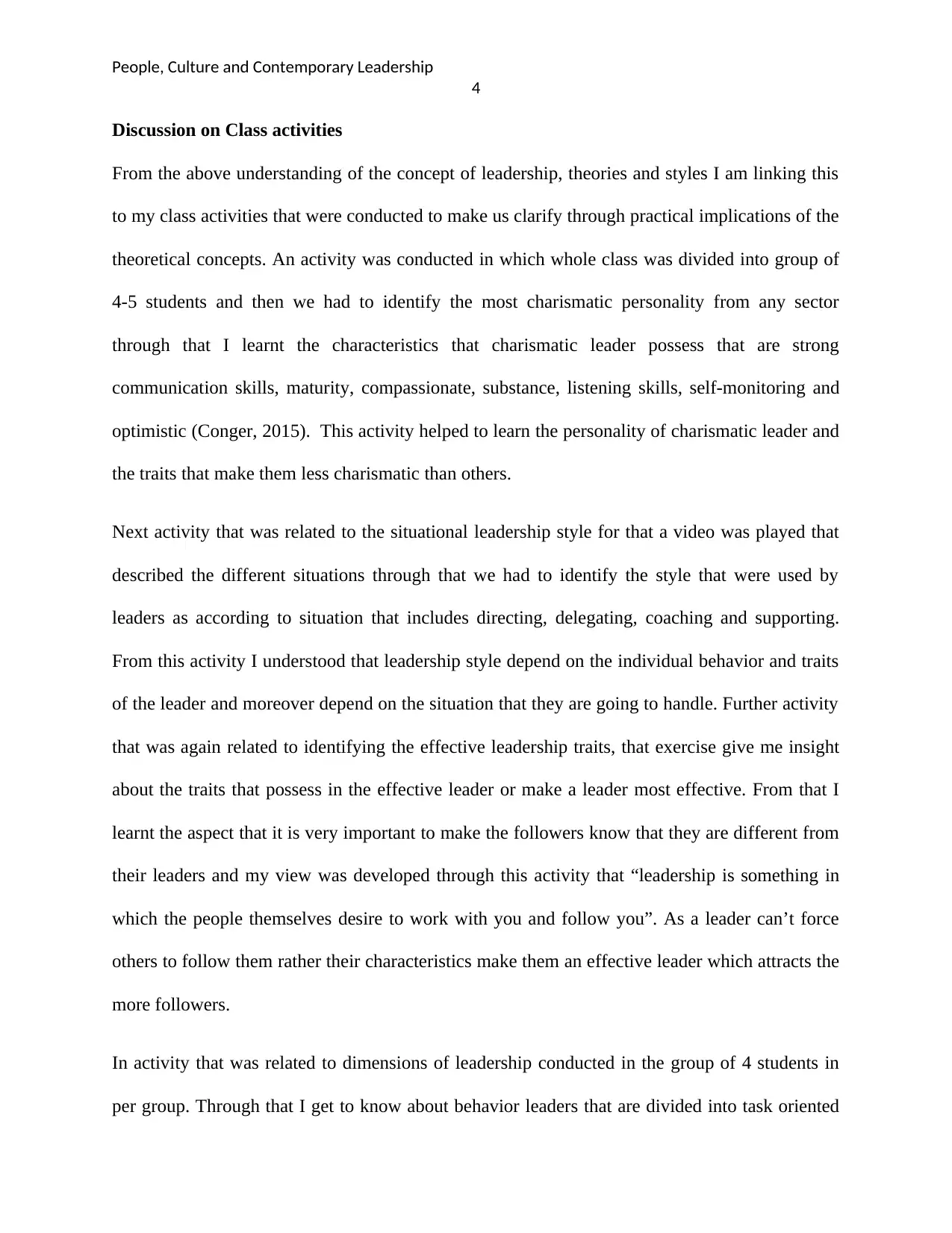
People, Culture and Contemporary Leadership
4
Discussion on Class activities
From the above understanding of the concept of leadership, theories and styles I am linking this
to my class activities that were conducted to make us clarify through practical implications of the
theoretical concepts. An activity was conducted in which whole class was divided into group of
4-5 students and then we had to identify the most charismatic personality from any sector
through that I learnt the characteristics that charismatic leader possess that are strong
communication skills, maturity, compassionate, substance, listening skills, self-monitoring and
optimistic (Conger, 2015). This activity helped to learn the personality of charismatic leader and
the traits that make them less charismatic than others.
Next activity that was related to the situational leadership style for that a video was played that
described the different situations through that we had to identify the style that were used by
leaders as according to situation that includes directing, delegating, coaching and supporting.
From this activity I understood that leadership style depend on the individual behavior and traits
of the leader and moreover depend on the situation that they are going to handle. Further activity
that was again related to identifying the effective leadership traits, that exercise give me insight
about the traits that possess in the effective leader or make a leader most effective. From that I
learnt the aspect that it is very important to make the followers know that they are different from
their leaders and my view was developed through this activity that “leadership is something in
which the people themselves desire to work with you and follow you”. As a leader can’t force
others to follow them rather their characteristics make them an effective leader which attracts the
more followers.
In activity that was related to dimensions of leadership conducted in the group of 4 students in
per group. Through that I get to know about behavior leaders that are divided into task oriented
4
Discussion on Class activities
From the above understanding of the concept of leadership, theories and styles I am linking this
to my class activities that were conducted to make us clarify through practical implications of the
theoretical concepts. An activity was conducted in which whole class was divided into group of
4-5 students and then we had to identify the most charismatic personality from any sector
through that I learnt the characteristics that charismatic leader possess that are strong
communication skills, maturity, compassionate, substance, listening skills, self-monitoring and
optimistic (Conger, 2015). This activity helped to learn the personality of charismatic leader and
the traits that make them less charismatic than others.
Next activity that was related to the situational leadership style for that a video was played that
described the different situations through that we had to identify the style that were used by
leaders as according to situation that includes directing, delegating, coaching and supporting.
From this activity I understood that leadership style depend on the individual behavior and traits
of the leader and moreover depend on the situation that they are going to handle. Further activity
that was again related to identifying the effective leadership traits, that exercise give me insight
about the traits that possess in the effective leader or make a leader most effective. From that I
learnt the aspect that it is very important to make the followers know that they are different from
their leaders and my view was developed through this activity that “leadership is something in
which the people themselves desire to work with you and follow you”. As a leader can’t force
others to follow them rather their characteristics make them an effective leader which attracts the
more followers.
In activity that was related to dimensions of leadership conducted in the group of 4 students in
per group. Through that I get to know about behavior leaders that are divided into task oriented
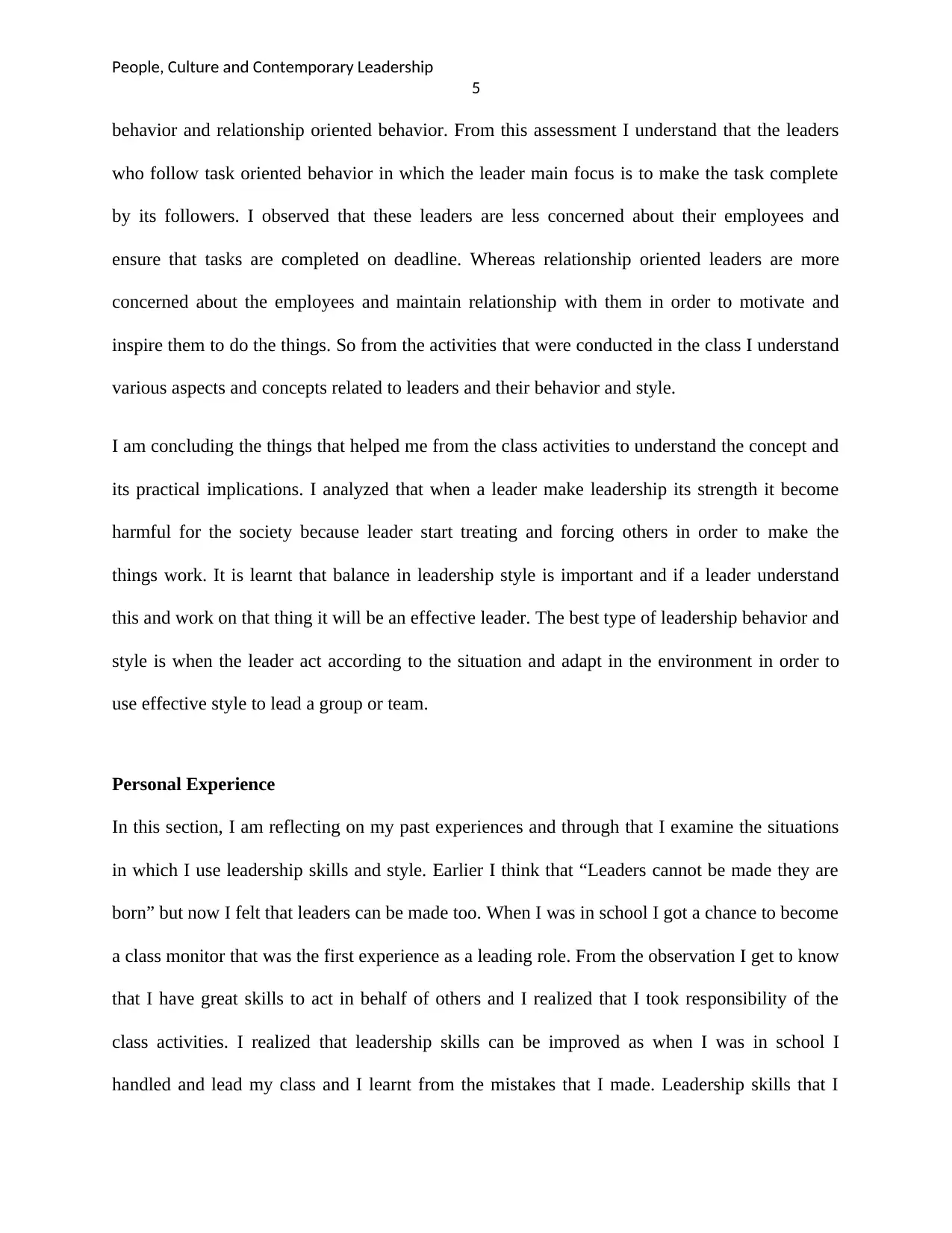
People, Culture and Contemporary Leadership
5
behavior and relationship oriented behavior. From this assessment I understand that the leaders
who follow task oriented behavior in which the leader main focus is to make the task complete
by its followers. I observed that these leaders are less concerned about their employees and
ensure that tasks are completed on deadline. Whereas relationship oriented leaders are more
concerned about the employees and maintain relationship with them in order to motivate and
inspire them to do the things. So from the activities that were conducted in the class I understand
various aspects and concepts related to leaders and their behavior and style.
I am concluding the things that helped me from the class activities to understand the concept and
its practical implications. I analyzed that when a leader make leadership its strength it become
harmful for the society because leader start treating and forcing others in order to make the
things work. It is learnt that balance in leadership style is important and if a leader understand
this and work on that thing it will be an effective leader. The best type of leadership behavior and
style is when the leader act according to the situation and adapt in the environment in order to
use effective style to lead a group or team.
Personal Experience
In this section, I am reflecting on my past experiences and through that I examine the situations
in which I use leadership skills and style. Earlier I think that “Leaders cannot be made they are
born” but now I felt that leaders can be made too. When I was in school I got a chance to become
a class monitor that was the first experience as a leading role. From the observation I get to know
that I have great skills to act in behalf of others and I realized that I took responsibility of the
class activities. I realized that leadership skills can be improved as when I was in school I
handled and lead my class and I learnt from the mistakes that I made. Leadership skills that I
5
behavior and relationship oriented behavior. From this assessment I understand that the leaders
who follow task oriented behavior in which the leader main focus is to make the task complete
by its followers. I observed that these leaders are less concerned about their employees and
ensure that tasks are completed on deadline. Whereas relationship oriented leaders are more
concerned about the employees and maintain relationship with them in order to motivate and
inspire them to do the things. So from the activities that were conducted in the class I understand
various aspects and concepts related to leaders and their behavior and style.
I am concluding the things that helped me from the class activities to understand the concept and
its practical implications. I analyzed that when a leader make leadership its strength it become
harmful for the society because leader start treating and forcing others in order to make the
things work. It is learnt that balance in leadership style is important and if a leader understand
this and work on that thing it will be an effective leader. The best type of leadership behavior and
style is when the leader act according to the situation and adapt in the environment in order to
use effective style to lead a group or team.
Personal Experience
In this section, I am reflecting on my past experiences and through that I examine the situations
in which I use leadership skills and style. Earlier I think that “Leaders cannot be made they are
born” but now I felt that leaders can be made too. When I was in school I got a chance to become
a class monitor that was the first experience as a leading role. From the observation I get to know
that I have great skills to act in behalf of others and I realized that I took responsibility of the
class activities. I realized that leadership skills can be improved as when I was in school I
handled and lead my class and I learnt from the mistakes that I made. Leadership skills that I
⊘ This is a preview!⊘
Do you want full access?
Subscribe today to unlock all pages.

Trusted by 1+ million students worldwide
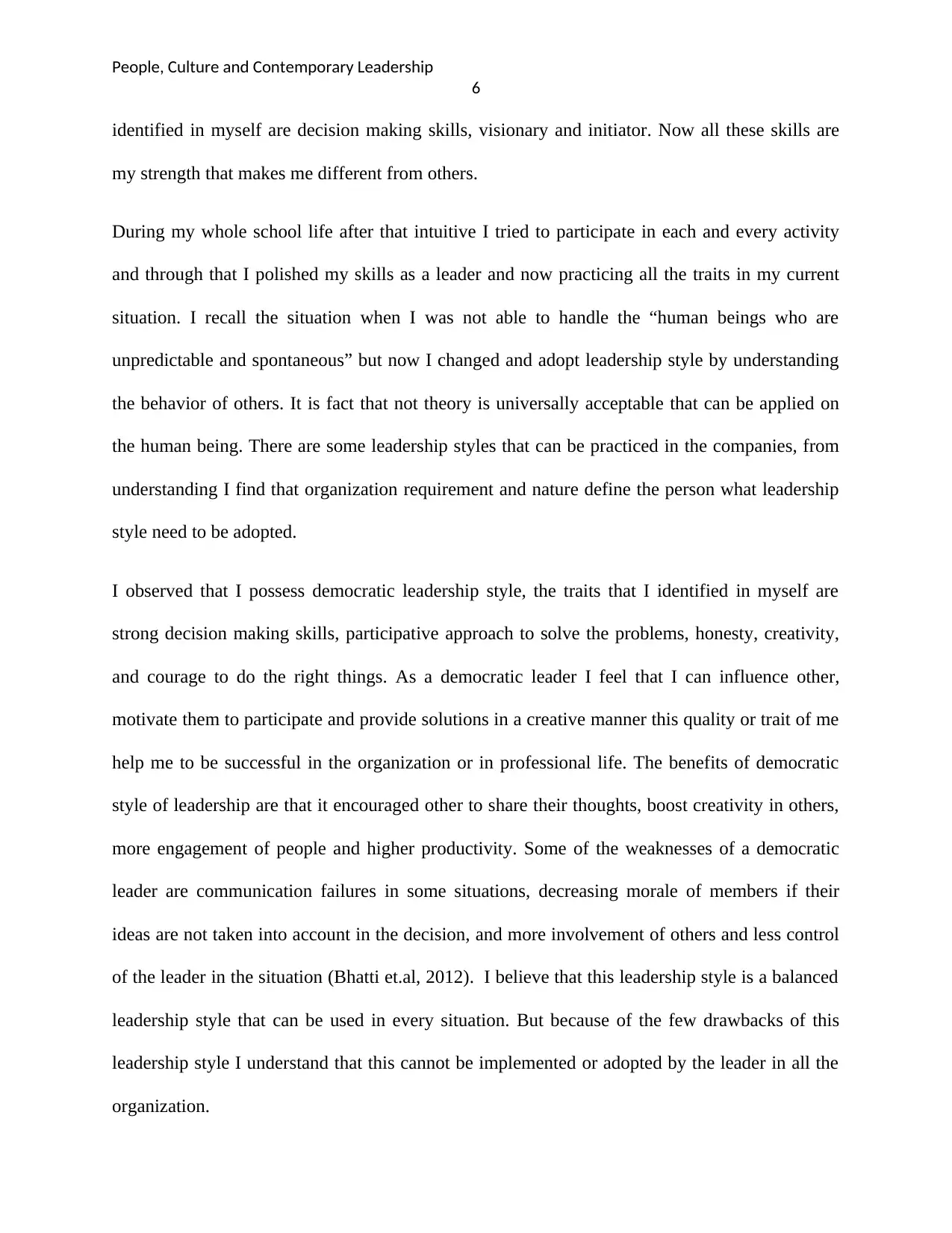
People, Culture and Contemporary Leadership
6
identified in myself are decision making skills, visionary and initiator. Now all these skills are
my strength that makes me different from others.
During my whole school life after that intuitive I tried to participate in each and every activity
and through that I polished my skills as a leader and now practicing all the traits in my current
situation. I recall the situation when I was not able to handle the “human beings who are
unpredictable and spontaneous” but now I changed and adopt leadership style by understanding
the behavior of others. It is fact that not theory is universally acceptable that can be applied on
the human being. There are some leadership styles that can be practiced in the companies, from
understanding I find that organization requirement and nature define the person what leadership
style need to be adopted.
I observed that I possess democratic leadership style, the traits that I identified in myself are
strong decision making skills, participative approach to solve the problems, honesty, creativity,
and courage to do the right things. As a democratic leader I feel that I can influence other,
motivate them to participate and provide solutions in a creative manner this quality or trait of me
help me to be successful in the organization or in professional life. The benefits of democratic
style of leadership are that it encouraged other to share their thoughts, boost creativity in others,
more engagement of people and higher productivity. Some of the weaknesses of a democratic
leader are communication failures in some situations, decreasing morale of members if their
ideas are not taken into account in the decision, and more involvement of others and less control
of the leader in the situation (Bhatti et.al, 2012). I believe that this leadership style is a balanced
leadership style that can be used in every situation. But because of the few drawbacks of this
leadership style I understand that this cannot be implemented or adopted by the leader in all the
organization.
6
identified in myself are decision making skills, visionary and initiator. Now all these skills are
my strength that makes me different from others.
During my whole school life after that intuitive I tried to participate in each and every activity
and through that I polished my skills as a leader and now practicing all the traits in my current
situation. I recall the situation when I was not able to handle the “human beings who are
unpredictable and spontaneous” but now I changed and adopt leadership style by understanding
the behavior of others. It is fact that not theory is universally acceptable that can be applied on
the human being. There are some leadership styles that can be practiced in the companies, from
understanding I find that organization requirement and nature define the person what leadership
style need to be adopted.
I observed that I possess democratic leadership style, the traits that I identified in myself are
strong decision making skills, participative approach to solve the problems, honesty, creativity,
and courage to do the right things. As a democratic leader I feel that I can influence other,
motivate them to participate and provide solutions in a creative manner this quality or trait of me
help me to be successful in the organization or in professional life. The benefits of democratic
style of leadership are that it encouraged other to share their thoughts, boost creativity in others,
more engagement of people and higher productivity. Some of the weaknesses of a democratic
leader are communication failures in some situations, decreasing morale of members if their
ideas are not taken into account in the decision, and more involvement of others and less control
of the leader in the situation (Bhatti et.al, 2012). I believe that this leadership style is a balanced
leadership style that can be used in every situation. But because of the few drawbacks of this
leadership style I understand that this cannot be implemented or adopted by the leader in all the
organization.
Paraphrase This Document
Need a fresh take? Get an instant paraphrase of this document with our AI Paraphraser
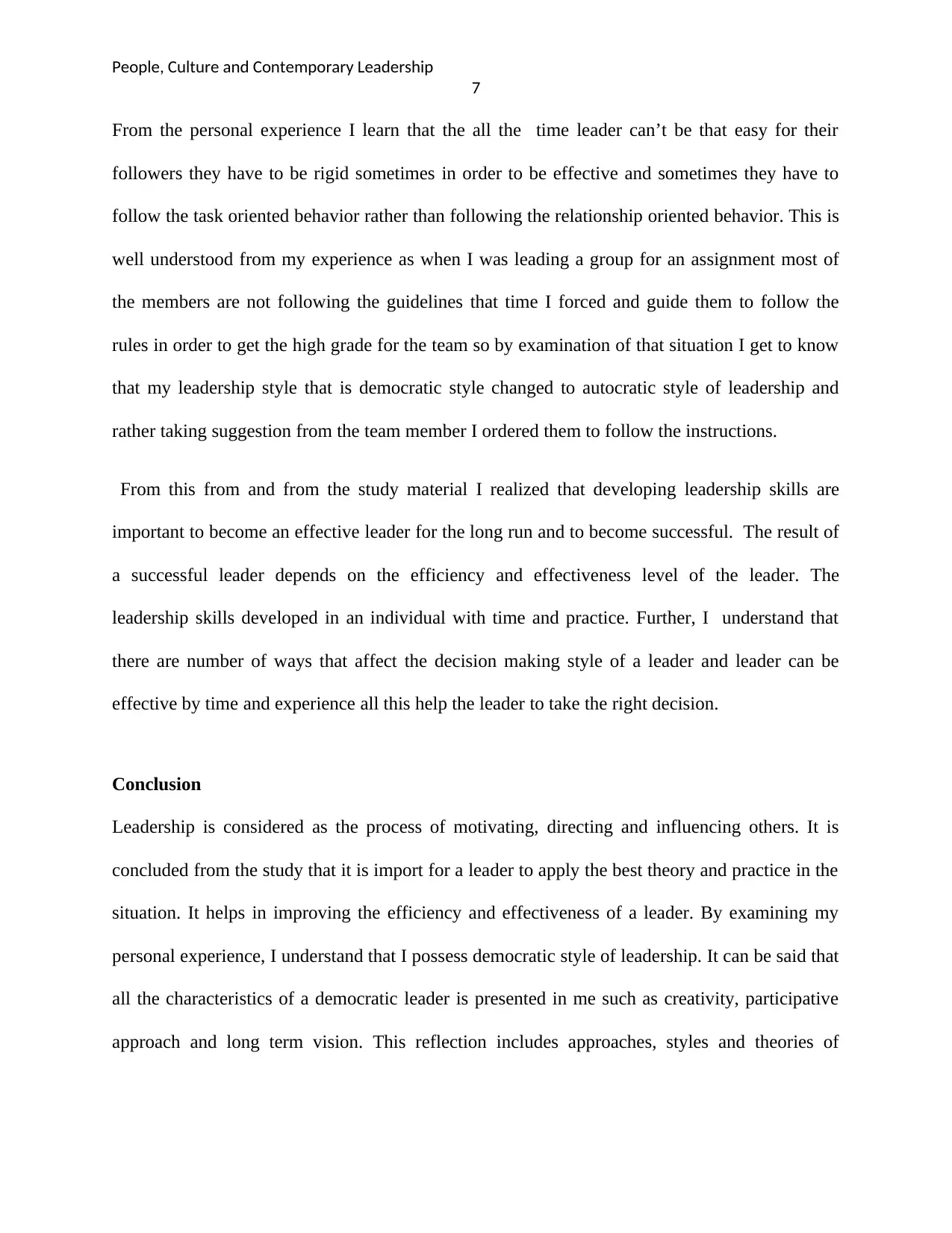
People, Culture and Contemporary Leadership
7
From the personal experience I learn that the all the time leader can’t be that easy for their
followers they have to be rigid sometimes in order to be effective and sometimes they have to
follow the task oriented behavior rather than following the relationship oriented behavior. This is
well understood from my experience as when I was leading a group for an assignment most of
the members are not following the guidelines that time I forced and guide them to follow the
rules in order to get the high grade for the team so by examination of that situation I get to know
that my leadership style that is democratic style changed to autocratic style of leadership and
rather taking suggestion from the team member I ordered them to follow the instructions.
From this from and from the study material I realized that developing leadership skills are
important to become an effective leader for the long run and to become successful. The result of
a successful leader depends on the efficiency and effectiveness level of the leader. The
leadership skills developed in an individual with time and practice. Further, I understand that
there are number of ways that affect the decision making style of a leader and leader can be
effective by time and experience all this help the leader to take the right decision.
Conclusion
Leadership is considered as the process of motivating, directing and influencing others. It is
concluded from the study that it is import for a leader to apply the best theory and practice in the
situation. It helps in improving the efficiency and effectiveness of a leader. By examining my
personal experience, I understand that I possess democratic style of leadership. It can be said that
all the characteristics of a democratic leader is presented in me such as creativity, participative
approach and long term vision. This reflection includes approaches, styles and theories of
7
From the personal experience I learn that the all the time leader can’t be that easy for their
followers they have to be rigid sometimes in order to be effective and sometimes they have to
follow the task oriented behavior rather than following the relationship oriented behavior. This is
well understood from my experience as when I was leading a group for an assignment most of
the members are not following the guidelines that time I forced and guide them to follow the
rules in order to get the high grade for the team so by examination of that situation I get to know
that my leadership style that is democratic style changed to autocratic style of leadership and
rather taking suggestion from the team member I ordered them to follow the instructions.
From this from and from the study material I realized that developing leadership skills are
important to become an effective leader for the long run and to become successful. The result of
a successful leader depends on the efficiency and effectiveness level of the leader. The
leadership skills developed in an individual with time and practice. Further, I understand that
there are number of ways that affect the decision making style of a leader and leader can be
effective by time and experience all this help the leader to take the right decision.
Conclusion
Leadership is considered as the process of motivating, directing and influencing others. It is
concluded from the study that it is import for a leader to apply the best theory and practice in the
situation. It helps in improving the efficiency and effectiveness of a leader. By examining my
personal experience, I understand that I possess democratic style of leadership. It can be said that
all the characteristics of a democratic leader is presented in me such as creativity, participative
approach and long term vision. This reflection includes approaches, styles and theories of
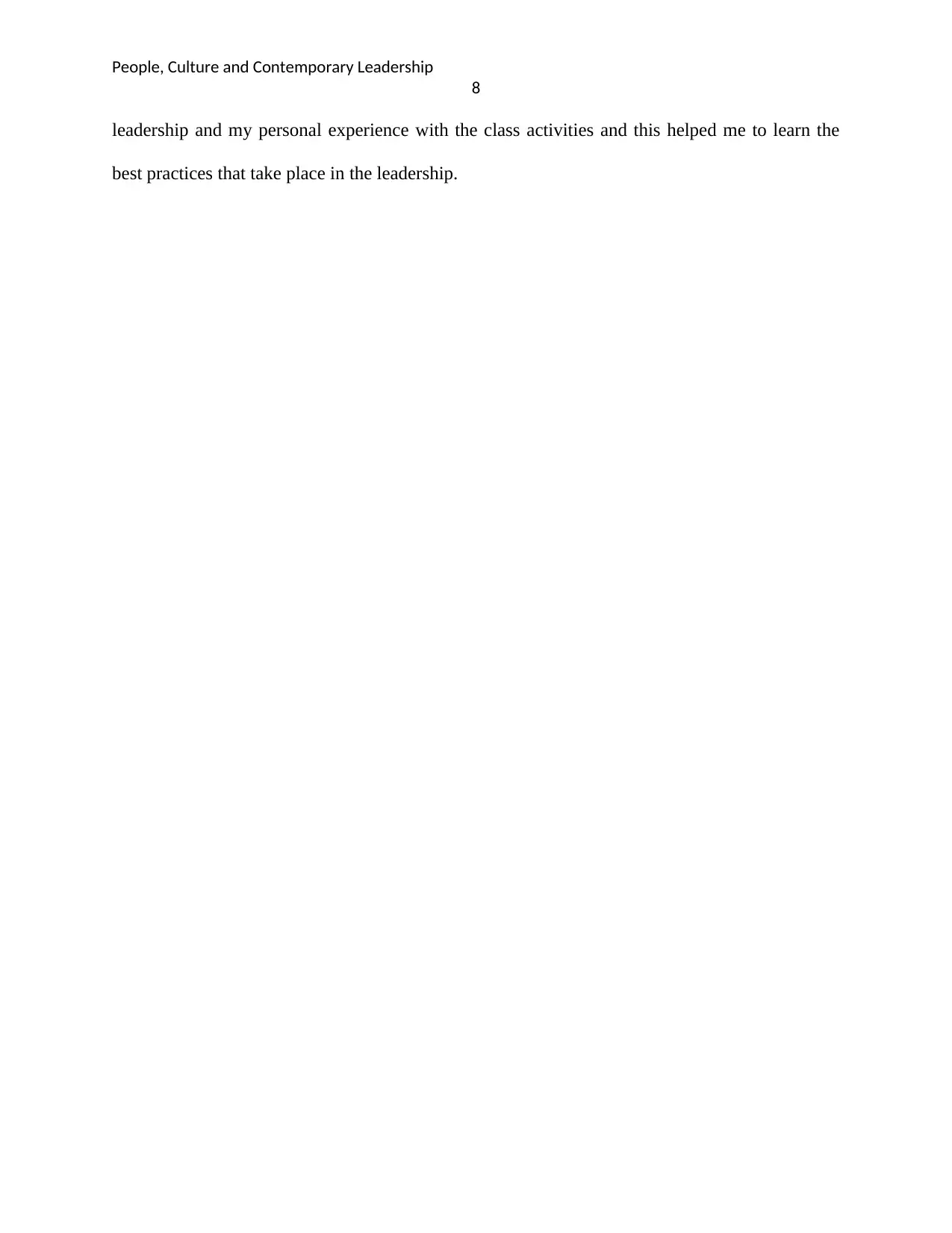
People, Culture and Contemporary Leadership
8
leadership and my personal experience with the class activities and this helped me to learn the
best practices that take place in the leadership.
8
leadership and my personal experience with the class activities and this helped me to learn the
best practices that take place in the leadership.
⊘ This is a preview!⊘
Do you want full access?
Subscribe today to unlock all pages.

Trusted by 1+ million students worldwide

People, Culture and Contemporary Leadership
9
References
Antonakis, J. and Day, D.V. eds., 2017. The nature of leadership. Sage publications.
Behrendt, P., Matz, S. and Göritz, A.S., 2017. An integrative model of leadership behavior. The
leadership quarterly, 28(1), pp.229-244.
Bhatti, N., Maitlo, G.M., Shaikh, N., Hashmi, M.A. and Shaikh, F.M., 2012. The impact of
autocratic and democratic leadership style on job satisfaction. International Business
Research, 5(2), p.192.
Blomme, R.J., Kodden, B. and Beasley-Suffolk, A., 2015. Leadership theories and the concept of
work engagement: Creating a conceptual framework for management implications and
research. Journal of Management & Organization, 21(2), pp.125-144.
Conger, J., 2015. Charismatic leadership. Wiley encyclopedia of management, pp.1-2.
Northouse, P.G., 2018. Leadership: Theory and practice. Sage publications.
Storey, J., 2016. Changing theories of leadership and leadership development. In Leadership in
Organizations (pp. 17-41). Routledge.
Western, S., 2019. Leadership: A critical text. SAGE Publications Limited.
Yahaya, R. and Ebrahim, F., 2016. Leadership styles and organizational commitment: literature
review. Journal of Management Development, 35(2), pp.190-216.
9
References
Antonakis, J. and Day, D.V. eds., 2017. The nature of leadership. Sage publications.
Behrendt, P., Matz, S. and Göritz, A.S., 2017. An integrative model of leadership behavior. The
leadership quarterly, 28(1), pp.229-244.
Bhatti, N., Maitlo, G.M., Shaikh, N., Hashmi, M.A. and Shaikh, F.M., 2012. The impact of
autocratic and democratic leadership style on job satisfaction. International Business
Research, 5(2), p.192.
Blomme, R.J., Kodden, B. and Beasley-Suffolk, A., 2015. Leadership theories and the concept of
work engagement: Creating a conceptual framework for management implications and
research. Journal of Management & Organization, 21(2), pp.125-144.
Conger, J., 2015. Charismatic leadership. Wiley encyclopedia of management, pp.1-2.
Northouse, P.G., 2018. Leadership: Theory and practice. Sage publications.
Storey, J., 2016. Changing theories of leadership and leadership development. In Leadership in
Organizations (pp. 17-41). Routledge.
Western, S., 2019. Leadership: A critical text. SAGE Publications Limited.
Yahaya, R. and Ebrahim, F., 2016. Leadership styles and organizational commitment: literature
review. Journal of Management Development, 35(2), pp.190-216.
1 out of 10
Related Documents
Your All-in-One AI-Powered Toolkit for Academic Success.
+13062052269
info@desklib.com
Available 24*7 on WhatsApp / Email
![[object Object]](/_next/static/media/star-bottom.7253800d.svg)
Unlock your academic potential
Copyright © 2020–2025 A2Z Services. All Rights Reserved. Developed and managed by ZUCOL.




